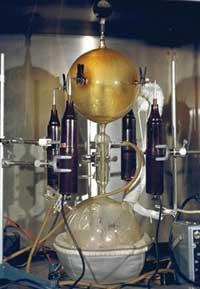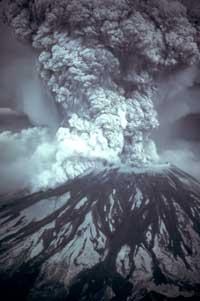In volcanoes perhaps yes

However, ignorance does not mean that no one has tried, much less. On several occasions it has been tried to explain and repeat what was the means of the time and what happened with the appearance of organic molecules. But no trial has succeeded in satisfying the scientists who practice it.
Of course, scientists continue their work of testing their hypotheses. They have now found a possible explanation for the first experiment that took place in this field and has been released in the journal Science.
Miller and soup of principle
Stanley Miller first demonstrated that organic molecules can form in an inorganic medium. He did so in 1953 under the tutelage of Nobel Prize winner Harold Urey (then Miller was a doctoral student). It simulated the atmosphere of the time when organic molecules were formed and caused the rays, so abundant then, with the help of electrodes.

And he got what he expected! In a medium where only inorganic molecules appeared, among others, amino acids (basic components of proteins). So Miller said these molecules were formed: The components and conditions of the Earth's atmosphere formed an initial zopa’ of inspiration, which was triggered by lightning.
The credibility of this experiment was decreasing among scientists, as over time experts believe that the atmosphere of the time did not have the composition proposed by Miller. They say Miller used more hydrogen than there was. Therefore, if it did not reproduce correctly the conditions of the time, it is useless to infer anything from that experiment.
Better experiment than expected
Chemist Stanley Miller died last year and geochemists Jim Cleaves and Jeffrey Bada, two former Miller students, entered his laboratory to analyze what was there. On that road the jars of Miller's famous experiment were found (yes, they kept them for fifty years).

They decided to resume Miller's result with current technology. They studied its contents with a very sensitive tool, a NASA mass spectrometer, and saw that Miller achieved a much better result than expected. In 1953, Miller stated that in his experiment five amino acids were synthesized, while the current team has found twenty-two amino acids in the same sample, among which are all that appear in the proteins of living beings, what a point!
Of course, they have wanted to explain in some way that in the experiment of Miller appeared all the amino acids of the proteins, considering that it was almost impossible that at that time there existed the atmosphere proposed by him. Well, they have stated that Miller's conditions could be in the clouds of gas formed by volcanoes so abundant then on Earth, and that its components have been formed in specific restricted areas.
As we have already said, we don't know if the conditions of Miller's experiment were never and nowhere, and we'll go on without knowing where those initial molecules came from. However, some scientists have opted only for Miller's experiment because it makes clear, at least, that it is possible to form organic molecules in inorganic conditions.
Published in 7K.
Buletina
Bidali zure helbide elektronikoa eta jaso asteroko buletina zure sarrera-ontzian











